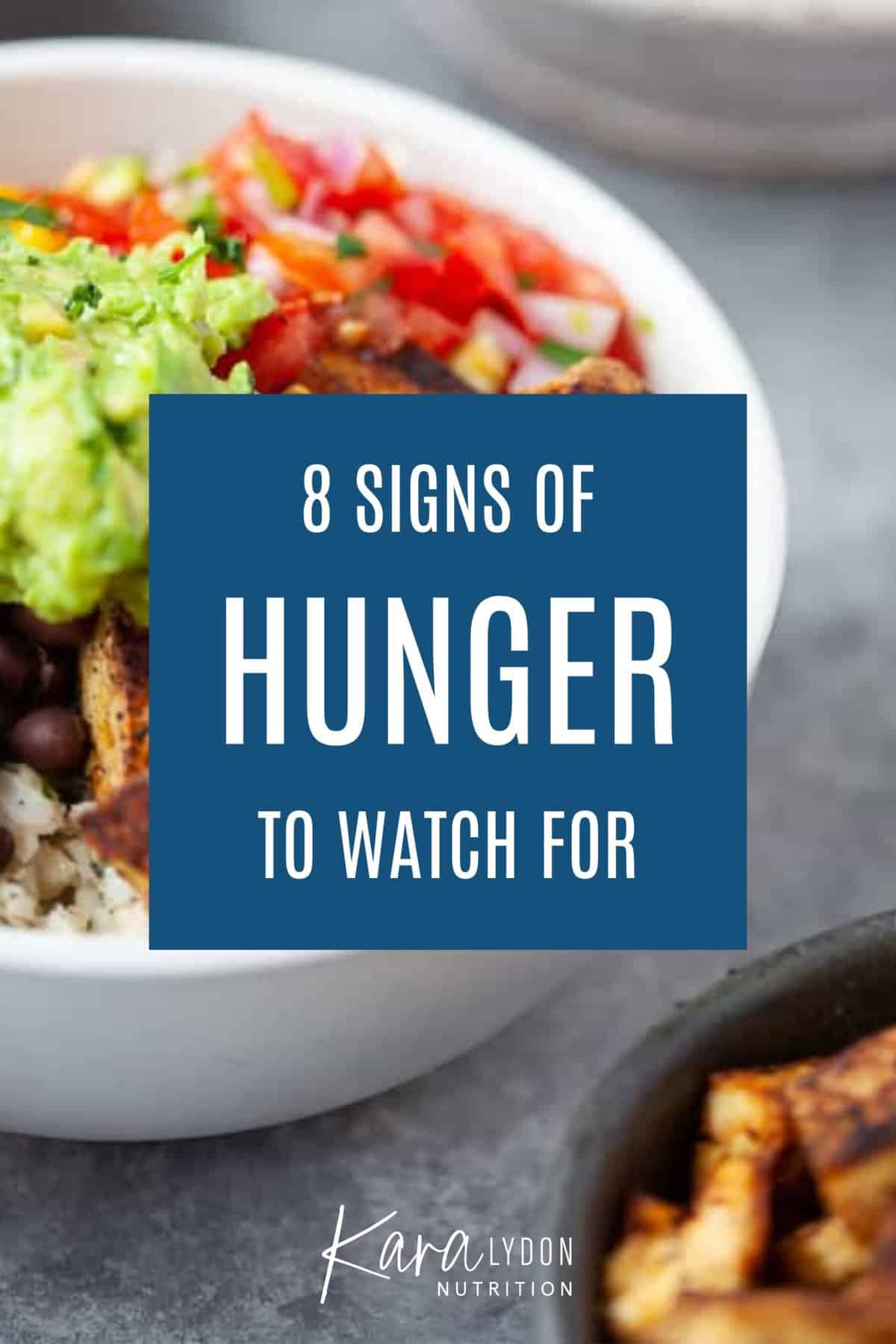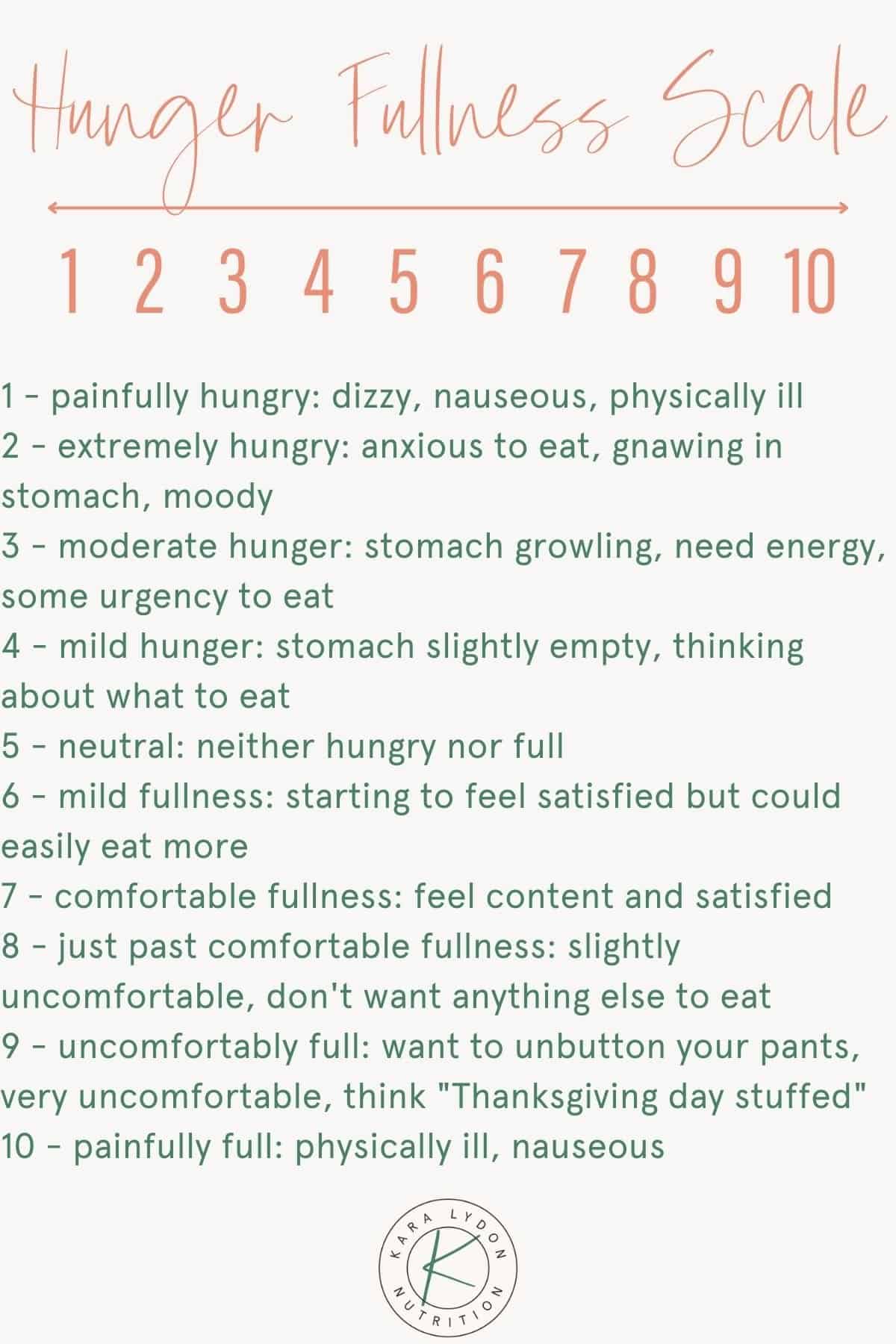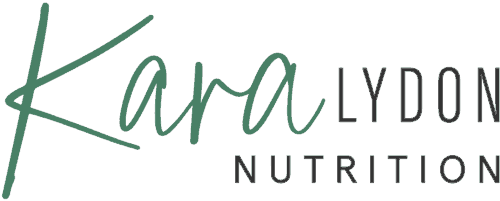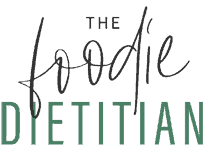Ever wonder if you’re actually hungry? This blog post takes a deep dive into hunger cues: the 4 types of hunger, 8 signs of hunger to watch for, a scale to help determine your degree of hunger, and background on how you’ve been conditioned to mistrust your hunger cues.

Do you ever question whether or not you’re actually hungry?
Do you ever second-guess your hunger? Wondering if it’s something else? Doubting that you could actually be hungry?
Do you ever find yourself ravenous by the time you sit down to eat? Do you struggle to notice hunger until it’s too late?
If you answered yes to any of the above questions, this post about signs of hunger is for you!
We’ve been conditioned to mistrust hunger
Hunger is a natural physiological cue that alerts us when it’s time to eat. When your stomach is empty, it produces ghrelin, a hormone that travels through the bloodstream to the part of the brain (hypothalamus) that regulates hunger (among other physical functions).
When you were young (before you were conditioned by diet culture), you probably noticed hunger signals and you responded to them by eating. It wasn’t all that complicated.
But somewhere along the way, you were taught to override your hunger signals. That if you were hungry all the time, it meant you had willpower.
You were taught that hunger could easily be mistaken for thirst and that you should just drink a lot of water instead of eating.
You were taught that you probably weren’t physically hungry, it was just all in your head.
You started to mistrust your hunger. You started to fear your hunger. And maybe one day you stopped noticing hunger.
Diet culture does a wonderful job at convincing you that hunger is a bad thing. That you need to override what your body is telling you in an attempt to lose weight. It tells you that you are “doing it right” if you’re hungry all the time.
Diet culture is an effing liar. It disconnects you from your body’s wisdom. It makes you believe that your body cannot be trusted.
Let me ask you this to put things into perspective: Have you ever been taught to second guess your body’s cue to go pee? Have you ever been told that you have so much willpower if you fight the urge to go pee? Have you ever been conditioned to fear the urge to pee?
No, of course you haven’t! That would be ridiculous. Because relieving yourself is morally neutral. Whereas hunger is a loaded cue.
But hunger and the urge to pee are both inherently neutral physiological signals – it’s just that our culture has attached meaning to one and not to the other.
4 Types of Hunger: Physical, Emotional, Taste, and Practical
Physical Hunger
Physical Hunger starts out gradual and builds over time. This is a type of hunger you would feel via bodily sensations like a grumbling stomach, inability to focus, salivating, and it’s generally satisfied by eating enough.
Emotional Hunger
Emotional hunger gets a bad rep. We’ve been taught that emotional eating is “bad” but emotional eating is a very normal part of being a human being. Food is meant to be pleasurable and comforting – if it wasn’t, we wouldn’t be as inclined to eat (see more in this article I wrote for SHAPE.com on emotional eating)
Emotional eating comes on faster than physical hunger and you might have a taste for something specific (i.e. a comfort food). Emotional eating only becomes problematic if it’s the only tool you have in your tool belt for coping with emotions.
Taste Hunger
Taste hunger is when you have a taste for something very specific. This could also be referred to as a craving. Taste hunger can overlap with emotional hunger but it doesn’t have to. You might be having an emotionally neutral day but still have a taste for something specific.
Taste hunger can also overlap with physical hunger but it doesn’t have to. Let’s say you’re noticing physical hunger and you are craving a turkey sandwich – that’s both taste and physical hunger. Let’s say you just finished dinner and you have a craving for some chocolate – that’s taste hunger.
Practical Hunger
This is also referred to in the Intuitive Eating book as eating as an act of self-care. Practical hunger is when you’re not physically hungry – yet – but you know you need to eat something because of when you likely will get hungry and food might not be accessible at that time.
A perfect example is you have class at 9am and you’re not allowed to eat during class. You wake up at 8am and you’re not hungry yet but you know that by 9am you will be hungry. As an act of self-care, you eat at 8:30am before heading out the door so that you’re not starving by the end of class.
8 Signs of Physical Hunger
Most people think of hunger as residing in the stomach and struggle to notice other subtle (or not-so-subtle) signs and symptoms of hunger. Here are some other signs that might mean you’re hungry! Some of these signs overlap with signs you may not be eating enough.
1. Stomach gnawing, grumbling, feeling empty
Many people recognize feeling hunger in their stomach – you might hear some growling or sense some grumbling. Maybe you feel an ache or gnawing in your stomach or you have a sense that your stomach feels empty.
2. Headache
When you are hungry, typically your blood sugar is low because you haven’t eaten in a while – low blood sugar levels can result in headaches.
3. Inability to focus / concentrate
When your brain isn’t well nourished, it can feel challenging to concentrate on work or focus on the task at hand. You also might find yourself thinking about food, which makes it hard to concentrate.
4. Feeling Irritable
Hanger is for reallllll. If you’ve ever snapped at your partner or friend when you were hungry, you’re not alone. Been there, done that. When blood sugar levels are low, it’s common to experience some irritability or anger (hanger!).
5. Anxious
For others, low blood sugar can manifest as anxiety. Maybe you start to get shaky or sweaty or your heart starts to race or you begin to ruminate – these could all be signs of hunger.
6. Dizzy or lightheaded
This is usually a hunger sign that means you’re past the point of gentle hunger (see hunger scale below). If you’re feeling dizzy or lightheaded, you probably missed a more subtle hunger cue along the way.
7. Fatigue
Maybe you didn’t sleep well the night before…or maybe you’re just hungry? You’ve probably heard of folks reaching for that second (or third) cup of coffee (or maybe that’s you!) to combat the mid-afternoon slump. But what if your body is actually hungry mid-afternoon and it needs nourishment, not just caffeine? Not having enough fuel in the tank in terms of energy from calories can cause you to feel tired and sluggish.
8. Salivating
Our body produces extra saliva in response to hunger. Ever notice how you might have more saliva when you smell a batch of freshly baked cookies coming out of the oven? That’s your body’s way of preparing to eat!
So how do you know if all of these symptoms are a result of hunger or something else? You start to pay attention with curiosity and begin to notice patterns over time.
If you notice any of these symptoms, try asking yourself “is it possible that I could be experiencing physical hunger right now?” “When is the last time I had something to eat?”
How hungry are you?
Have you ever seen a hunger / fullness scale? This can be a helpful tool to clue you into just how hungry you are.
Ideally you want to be eating around a 3-4 on the hunger scale. If you’re eating at a 1 or a 2, you’re overly hungry, and you might be more likely to eat past comfortable fullness, and likely won’t be able to actually enjoy what you’re eating.

Other Reasons Hunger Might Not Be Accessible
Diet culture interferes with our ability to honor our hunger but for others it might not be just about cultural conditioning.
Folks who are neurodivergent and folks with histories of trauma that make it difficult to connect with the body may have a harder time noticing hunger cues. For these folks, practical hunger and eating according to the clock or as an act of self-care may be the most nourishing choice.
I hope you found this post helpful! If you did, please leave a comment below. I’d love to hear from you!
If you liked this post, check out some of my other related Intuitive Eating blog posts:
Are you on the hunger fullness diet?
Am I eating enough? 8 signs you may be undereating
The beginner’s guide to Intuitive Eating
Top 10 Intuitive Eating books to help you heal your relationship with food

